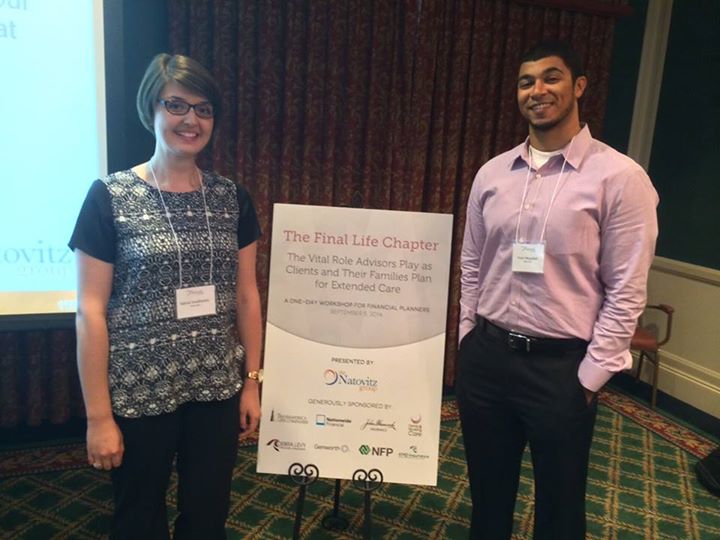The Final Life Chapter: The Natovitz Group

 The Natovitz group recently presented a one-day workshop for financial planners titled “The Final Life Chapter: The Vital Role Advisors Play as Clients and Their Families Plan for Extended Care.” Two of our Associate Financial Planners, Sabina and Yusuf, joined a group of local professionals at the Five Star Premier Residences for a day of learning. We thought we’d share a few highlights from the workshop!
The Natovitz group recently presented a one-day workshop for financial planners titled “The Final Life Chapter: The Vital Role Advisors Play as Clients and Their Families Plan for Extended Care.” Two of our Associate Financial Planners, Sabina and Yusuf, joined a group of local professionals at the Five Star Premier Residences for a day of learning. We thought we’d share a few highlights from the workshop!
Speaker Sessions
The Other Talk – a guide to talking with your adult children about the rest of your life (Tim Prosch)
As the first presenter of the day, Prosch began the discussion of final life chapter planning by addressing the need for open communication between generations, a topic he explores in depth in the book “The Other Talk.” The book provides advice on how to generate open and honest discussions with adult children to develop a plan for the future. This conversation is sensitive in nature because it addresses topics ranging from assisted living to funeral arrangements. “The Other Talk” can make people uncomfortable and is oftentimes avoided until a life-changing event has already taken place and the opportunity to plan for such an event has come and gone. We know that the conversation is important, but why do so many of us avoid having it? The answer is simple: the perception of the conversation itself. Prosch stated that we need to change the current perception by changing the:
- transaction from child intervention to parent initiative
- dynamic from child taking control or parent losing control to sharing control
- focus from end of life (which is oftentimes viewed as surrendering) to rest of life (which involves actively planning)
- feel from confrontation to collaboration
Changing the perception is only the beginning. Prosch outlines a methodology of final life chapter planning in “The Other Talk,” providing useful tips such as conversation starter topics and checklists for each step of the process. We encourage all of our clients engage in this type of conversation with their support system prior to crises that can thrust others into decision-making roles. In the end, we all want to ensure that our wishes are fulfilled and that the final chapter of our lives is not a burden to the ones we love.
Drafting Outside the Lines (Anne Coventry)
This session centered on the various documents often used in final life chapter planning. Coventry, an attorney and principal at Pasternak and Fidis, focused on documents not related to the minimization of taxes, ones that attorneys tend to put on the back burner, including the following:
- Advanced health care directives, also known as living wills, which are legal documents in which individuals specify what actions should be taken for their health if they are no longer able to make decisions for themselves because of illness or incapacity
- Power of Attorney for health care which is a legal documents that provides an agent the authority to represent or act on a grantor’s behalf in health care situations
Coventry also addressed the importance of a Power of Attorney for finances, which provides an agent the authority to represent or act on the grantor’s behalf in financial situations. Due to the difficulties individuals with Powers of Attorney have experienced as a result of the security protocols of financial institutions, Coventry also recommended that individuals request that the attorney draft a statutory form for the Power of Attorney. Even though this document may seem redundant, it forces financial institutions to cover any fees associated with the institution’s security protocols. In addition to these documents, Sabina and Yusuf found the Letters of Guidance particularly interesting. Although not legally binding, the document serves as a way for an individual to share his or her wishes regarding any number of topics from guardianship of children to long-term care arrangements. This document may reduce conflict in the future, as one’s wishes are clearly stated. However, the best approach remains sharing ones desires early on and taking the steps to ensure those are fulfilled.
Understanding the Retirement Living Landscape (Brad Breeding)
This session was a great reminder of the vast number of options individuals have when it comes to retirement living choices. The first choice an individual must make is whether to stay at home or join a retirement community, with pros and cons to consider for both. If one chooses the retirement community, the next question is what kind? Breeding, the author of “What’s the Deal with Retirement Communities” and president of LifeSite Logics, focused his presentation on Continuing Care Retirement Communities (CCRCs). These communities provide guaranteed access to the full continuum of care, beginning with fully independent care. There are various types of CCRCs, differing only in the realm of financing for care. Depending on the type of CCRC, one may even receive a tax deduction! As a CFP® who focuses on retirement communities, and CCRCs in particular, Breeding has developed a website that allows consumers to compare various communities based on numerous factors. The website provides comprehensive and objective information on these types of communities, guiding individuals in the decision-making process.
Long-Term Care Insurance: Latest Trends & Developments (Michael Kitces)
Michael Kitces concluded the workshop by sharing his insights on long-term care insurance, a topic of interest for many of our clients. Since most individuals cannot afford to self-insure against the high cost of long-term care, financial planners recommend purchasing insurance to mitigate the risk of depleting one’s financial assets to pay for necessary care. Unfortunately, long-term care insurance is also expensive and forces individuals to make trade-off decisions regarding which policy to purchase. Kitces described two groups: “short and fat” policies which have short durations and large (in comparison to other policies) daily benefit amounts and “long and thin” policies which have long durations and small daily benefit amounts. Of the two types, Kitces recommends purchasing “short and fat” policies because they cost less and can be treated as “long and thin policies” by filing claims that fall short of the maximum daily benefit since policies lapse when claims exceed the maximum lifetime benefit, not when the stated benefit period ends. Of course there are many other factors to consider when purchasing long-term care insurance, but if cost is the main concern, this may be the solution.
Aside from discussing how to best choose a policy, Kitces also addressed a topic that many of our clients with long-term care coverage have raised in recent conversations: significant premium increases ranging anywhere from 25 to 90 percent. Although alarming, it is important to note that these older policies are still cheaper than current ones offered in the marketplace simply due to the fact that the industry finally has a grasp on the appropriate pricing of long-term care policies. Nonetheless, the increases in premiums can make the coverage unaffordable and raise questions regarding how to maintain a policy at an affordable cost. Kitces stated that most clients should choose to reduce the benefit period, and older clients may reduce the rate on the inflation rider as well.
In an attempt to restore stability and regain profitability, the long-term care insurance industry has devised a new plan: a gender-based pricing structure. This means that unlike most other insurance products, women are likely to pay higher premiums than men when purchasing a comparable policy at a comparable age due to their longer life expectancies. This change in pricing structure began last Spring and is ALMOST fully rolled out across the industry, meaning there is STILL potential for consumers to purchase non-gender-based policies! Although we are all quick to see the negative impact of such a change in pricing structure, we must acknowledge that there is an upside: long-term care premiums will become more stable as accurate pricing reduces the risk of future premium increases for in-force policies. Who doesn’t like the sound of that?
Sabina and Yusuf had a great time and left the workshop equipped with ideas and solutions to incorporate in our work with clients moving forward.
